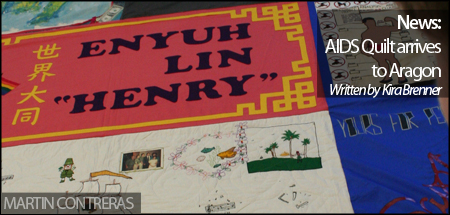
“There are two messages that the [AIDS quilt] sends out, first: the devastation of disease, and second: the disease effects all ages, races, sexual orientations, and genders. There is a story behind the disease, and in 2011 that story is no longer being shared on the level that it used to be,” said GSA Advisor Vince Bravo.
The AIDS Memorial Quilt, created by The NAMES Project Foundation, was on display at Aragon from April 18 to April 22.
Bravo arranged for Aragon to host the AIDS quilt. After Bravo picked up the quilt from the center in San Francisco, he drove it to Aragon in the back of his car trunk.
Bravo contacted the AIDS Emergency Relief Fund in San Francisco, and the organization agreed to let Aragon host the sections of the quilt.
There were four sections of the quilt on display in the Student Lunch Room. Each section of an AIDS quilt contains eight patches; each patch is an individual memorial for someone who passed away after suffering from HIV/AIDS. One of the patches was a memorial for a choir of 13, so there were a total of 44 people commemorated on the quilt sections that Aragon hosted.
Senior Nicole Beck said, “My mom passed away. There was one patch that really spoke to me… it said: ‘we’re not done talking yet.’ I could relate.”
Teachers received emails asking them to contact Bravo if they wanted to bring their classes to view the quilt for 20-30 minutes the week of the 18th. Bravo said, “There were a ton of periods that went in to view the quilt.”
Freshman Andisheh Kabiri said, “Before the quilt came to Aragon, what I knew [was] that it was a moving quilt, and that it moves people.”
The quilt is used in schools as an educational tool; it raises awareness about HIV/AIDS and provides a forum to have a discussion about the disease and those who are affected by it.
Bravo said, “It is important for more schools to host the quilt because it draws the awareness to the subject. It is in the news less, but it’s important to remember.”
Teachers reached a consensus that their students got the message. Hughes stood up to show how her students stood while viewing the quilt: heads down, feet together, hands clasped together, and solemn faces.
Hughes said, “It was humbling. [The students] rose to the occasion. They were somber and respectful.”
Junior Conrad Bracht, who saw the quilt in three different classes, said, “It seemed like an antique. No touching it… People put their hearts into their work.”
Health Teacher Steve Sell took his third period health class to see the quilt. Sell said, “Seeing the quilt raises empathy, it makes the risks of getting HIV tangible… it can seem obscure to teens who sometimes think that only gay people get HIV, there are real risks.”
“Sometimes teens feel invincible,” said Bravo, “the quilt is a message that it can happen to anyone, through various activities, and kids have died from it.”
Hontalas said, “[My favorite patch] was probably the one that was about Christmas. Perhaps the man was Santa for his family… Don’t you wonder what their stories are?”




